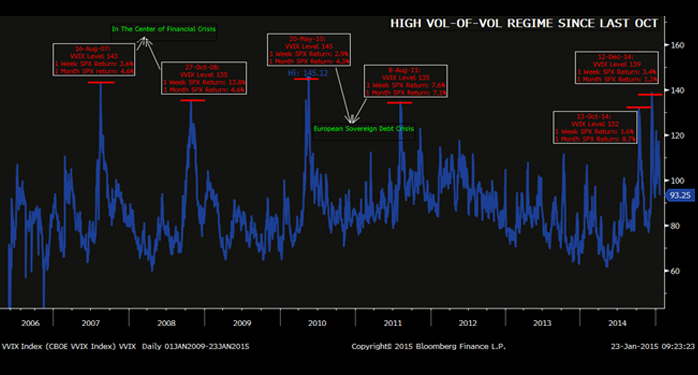The key to long term success as an asset manager is to have a convicted investment thesis, all the while watching market signals and filtering noise, remaining flexible enough to change your investment thesis should the signals demand it. This week, we will talk about the signaling from volatility of volatility, or "vol-of-vol."
Vol-of-vol is a measure of the market's perception of tail risk. If you look at the chart above, you can see vol-of-vol is currently at a very elevated level. This tells us that investors are nervous, worried about a shock in the market. This stands in contrast to the general consensus of an improving U.S. economy in 2015. (A better economy usually means a fairly quiet and less nervous market.)
We think a few forces are behind this heightened vol-of-vol:
- Distribution of risk changed after the aggressive monetary easing by policymakers all over the world. The easing reduces the risk around the body, but it increases the risk at the tail. More proof that there is no free lunch.
- Liquidity in the market is low. With heightened volatility, market makers' balance sheets are constrained, and a thin market is prone to sharp moves, as we witnessed recently in mid-October.
- The complex changes taking place in the global economic landscape has the market confused. To list a few of the changes: A sharp drop in the price of commodities, surprise from the Swiss National Bank, an economic slowdown in China, and deflation fears around the globe after monetary easing. It is hard for market participants to digest all these moving pieces, and this naturally increases the volatility of volatility in the market.
Key Takeaway: This high vol-of-vol is consistent with the negative yield we see in many sovereign bonds. The focus of many market participants is changing from "return on the money" to "return of the money". If we look at the difference between earning yield on equities (about 5.5% for the S&P 500 Index) and 10-year government bond yield (1.8% in U.S.), equity still looks like the better choice. But is "TINA" (there is no alternative) a good enough reason to buy equities?
The material provided here is for informational use only. The views expressed are those of the author, and do not necessarily reflect the views of Penn Mutual Asset Management.
This material is for informational use only. The views expressed are those of the author, and do not necessarily reflect the views of Penn Mutual Asset Management. This material is not intended to be relied upon as a forecast, research or investment advice, and it is not a recommendation, offer or solicitation to buy or sell any securities or to adopt any investment strategy.
Opinions and statements of financial market trends that are based on current market conditions constitute judgment of the author and are subject to change without notice. The information and opinions contained in this material are derived from sources deemed to be reliable but should not be assumed to be accurate or complete. Statements that reflect projections or expectations of future financial or economic performance of the markets may be considered forward-looking statements. Actual results may differ significantly. Any forecasts contained in this material are based on various estimates and assumptions, and there can be no assurance that such estimates or assumptions will prove accurate.
Investing involves risk, including possible loss of principal. Past performance is no guarantee of future results. All information referenced in preparation of this material has been obtained from sources believed to be reliable, but accuracy and completeness are not guaranteed. There is no representation or warranty as to the accuracy of the information and Penn Mutual Asset Management shall have no liability for decisions based upon such information.
High-Yield bonds are subject to greater fluctuations in value and risk of loss of income and principal. Investing in higher yielding, lower rated corporate bonds have a greater risk of price fluctuations and loss of principal and income than U.S. Treasury bonds and bills. Government securities offer a higher degree of safety and are guaranteed as to the timely payment of principal and interest if held to maturity.
All trademarks are the property of their respective owners. This material may not be reproduced in whole or in part in any form, or referred to in any other publication, without express written permission.


